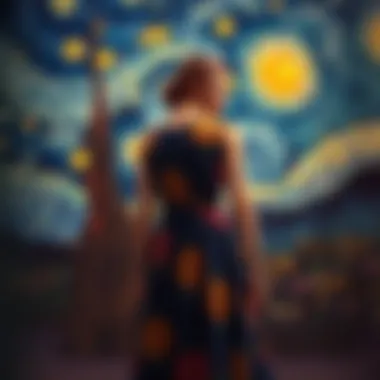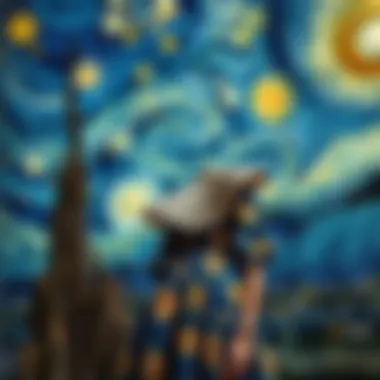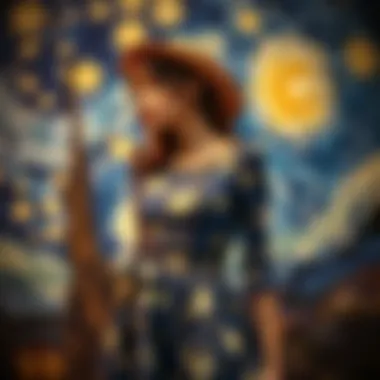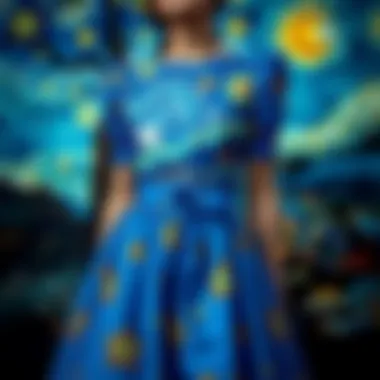Exploring the Van Gogh Starry Night Dress: Art Meets Fashion


Intro
The intersection of art and fashion often blurs boundaries, creating unique expressions that resonate deeply within culture and society. One striking example of this fusion is the Van Gogh Starry Night dress, which has captured the imaginations of fashion aficionados and art lovers alike. But what lies behind this captivating garment? How does it encapsulate the essence of Van Gogh's work, and what does it say about our current fashion landscape?
At its core, the Van Gogh Starry Night dress marries artistic brilliance with wearable design, prompting an exploration into its origins and the elements that contribute to its allure. As this article unfolds, it’ll dive into the fundamental design inspirations that underpin the dress’s creation, analyze the significance the original painting holds within contemporary fashion, and assess its cultural impact across different spheres.
By delving into its color palette and intricate design elements, readers can expect to gain a richer understanding of how this piece translates a celebrated masterpiece into something we can wear. Additionally, the discussion will include thoughts on the societal reception of such artistic fashion statements and offer practical styling tips for incorporating the Van Gogh aesthetic into everyday wardrobes.
This journey aims not only to appreciate fashion as art but also to inspire readers on how to engage with it actively, elevating personal style through the rich tapestry of history and creativity.
Preface to Art in Fashion
The intersection of art and fashion presents a vibrant tapestry of inspiration and innovation. It’s a world where colors, textures, and forms converge to create not only clothing but also statements that resonate with deep cultural significances. In this article, we will explore this dynamic relationship, with a particular focus on the Van Gogh Starry Night dress. This piece is not just an element of fashion; it embodies the dialogue between two powerful forms of expression.
Why Explore Art in Fashion?
Fashion, often deemed ephemeral, can carry profound attributes derived from artistic influences. Each thread in a garment can tell a story, similar to a brush stroke on a canvas. The importance of art in fashion lies in its ability to:
- Elevate aesthetic appeal
- Challenge societal norms
- Spark conversations about culture and identity
Through the lens of the Van Gogh Starry Night dress, we’ll see how designers draw upon historical art forms and modern interpretations alike, making wearers not just dressed, but also adorned in artistry. Moreover, understanding these intertwined realms can enhance critical thinking regarding consumer choices and the fashion industry’s role in sustainability.
The Interplay Between Fashion and Art
Fashion does not exist in a vacuum. It breathes through the interpretations of artists, who lend their visions to design. From couture runways to everyday attire, many garments evoke artistic narratives. The playful way designers use elements from renowned paintings is akin to a conversation between past and present – a mashup, if you will.
For instance, the swirling blues and yellows of Van Gogh's night sky, associated with emotions ranging from tranquility to turbulence, find expression in fabric. One could argue that wearing such a piece allows individuals to experience feelings similar to those originally captured on canvas. Just as Van Gogh used paint to convey his inner world, fashion designers craft weaves to mirror outer realities. This synergetic interplay enriches wardrobes, inviting discourse beyond mere aesthetics.
Historical Context of Artistic Fashion
To appreciate the Van Gogh Starry Night dress, it’s essential to contextualize its creation within a historical framework that interlinks art movements and fashion trends. Over centuries, various art styles have inspired fashion designers, reflecting societal changes and artistic evolution.
For instance, the Bloomsbury Group in early 20th century London had notable influences on both art and fashion, as did the aesthetics of the Art Nouveau movement. The connection is often symbiotic – as artists sought inspiration from textile patterns, designers turned to art for new visions.
In the contemporary landscape, the global embracement of pop culture and street art translates into high fashion. Designers like Alexander McQueen and Jean Paul Gaultier have previously pulled from artistic inspirations, blending various artist styles into their collections. This trajectory sets the stage for unique pieces like the Van Gogh dress, where the critical dialogue between various forms of creativity is evident. That's what gives fashion depth: an ongoing conversation enriched by historical influences.
"Art is not freedom from discipline, but disciplined freedom." - John F. Kennedy
Understanding this context allows us to appreciate how the Van Gogh Starry Night dress stands as a celebration of both the paintings that came before and the fashion that emerges today. This dress is not merely a piece of clothing; it's a reflection of the cultural zeitgeist and an homage to artistic heritage.
Van Gogh and His Artistic Legacy
Vincent van Gogh is not just a name in the world of art; he represents a bridge between raw human emotion and creativity on canvas. Van Gogh's artistic legacy goes far beyond the frames of his paintings; it seeps into multiple domains, one of which is fashion. Understanding his life and work helps illuminate the significance of garments inspired by his art, especially the Van Gogh Starry Night dress. This section elaborates on the depths of Van Gogh’s influence, touching on key aspects, benefits, and considerations.
Brief Overview of Van Gogh's Life


Vincent van Gogh’s life was nothing short of tumultuous. Born in 1853 in the Netherlands, Vincent’s journey in art began rather late. His works are marked by emotional depth, mystique, and vivid colors, which were starkly different from the ideals of convenience and commercialism characteristic of his time.
Despite his struggles with mental health and poverty, Van Gogh created over 2,000 artworks, including 860 oil paintings. What often gets overlooked is his unyielding commitment to express his inner turmoil through his work. He famously declared, "I dream my painting, and then I paint my dream." This statement encapsulates the very essence of his approach to art and, consequently, its influence on contemporary fashion.
The iconic painting Starry Night, created during his stay at the asylum in Saint-Rémy-de-Provence in 1889, showcases not just a sky filled with swirling stars but also a canvas brimming with emotion and visual poetry. His brush strokes are bold and expressive, capturing a beauty that speaks on emotional levels—elements that resonate within the realm of fashion, especially ones that aim to present more than just fabric.
Significance of Starry Night
Starry Night has transcended time, reshaping boundaries of artistic interpretation and appreciation. To understand its significance is to delve into the very soul of Van Gogh’s universe. The swirling blues and yellows the painting reveals are not mere colors; they're a narrative of turbulence, hope, and beauty juxtaposed together. The original brush strokes impart not just a visual experience, but an emotional landscape, allowing viewers to lose themselves in its depths.
Fashion designers who draw inspiration from this piece highlight that its influence extends into wearable art. To wear a dress modeled after Starry Night is more than a fashion statement; it's an expression of one’s identity, a canvas that reflects personal beliefs, feelings, and connection to the larger tapestry of life.
"Art is not what you see but what you make others see." – Edgar Degas
In a contemporary context, the Van Gogh Starry Night dress brings this idea full circle. It maintains the emotional resonance of the original artwork while evolving into a form that fits into modern aesthetic sensibilities. As it graces the bodies of fashion enthusiasts, it becomes an invitation to explore deeper themes of art, nature, and the complexities of human emotion—an embodiment of Van Gogh's legacy all stitched together with threads of modernity.
As such, Van Gogh’s life and works, particularly Starry Night, amplify the importance of expressing individuality through fashion that deeply resonates with the viewer. This perspective enhances the relevance of our exploration on the Van Gogh Starry Night dress, revealing layers of creativity and significance that move beyond the mere visual appeal of aesthetics.
Intro to the Van Gogh Starry Night Dress
The intersection of art and fashion forms an intriguing narrative that brings creativity into the realm of personal expression. One particularly captivating example is the Van Gogh Starry Night dress, which embodies a unique synergy between visual art and wearable design. This dress is not only a tribute to Vincent Van Gogh's brilliant strokes and swirling skies but also a celebration of how art can transcend its canvas and seep into our daily lives. By exploring the meticulous details of this dress, we can appreciate its significance in the broader context of artistic fashion.
Design Inspiration and Conceptualization
Creating the Van Gogh Starry Night dress begins with an understanding of Van Gogh’s artistic intentions. The design of the dress draws heavily from the swirling motion and color palette depicted in Starry Night. Rich navy blues juxtaposed with golden yellows evoke a sense of serenity, while its flowing silhouette mirrors the gentle undulations of the sky. The dress serves not just as an article of clothing, but rather as a canvas, reimagining Van Gogh's iconic masterpiece.
During the design phase, inspiration often stems from the emotional response the painting generates. Designers may find themselves captivated by the feeling of nostalgia or tranquility that Starry Night conveys. This emotional thread is what elevates the dress beyond simple fabric and stitches; it articulates a relationship between the wearer and the art itself.
Fashion creators channel Van Gogh’s spirit into the dress, aiming to spark conversations around artistic expression. This fusion challenges the traditional notions of fashion, allowing it to serve as a literal representation of cultural heritage. Vernacular inspirations such as nature, changes in seasons, and even the rhythms of city life often play a critical role in giving the dress a fresh perspective, transforming it instantaneously.
The Use of Color and Texture
Color and texture act as pivotal elements in bringing the Van Gogh Starry Night dress to life. The choice of deep blues and stark yellows doesn’t merely pay homage to the painting but also casts an emotional spell on its audience. Each hue is carefully selected not only for aesthetic appeal but also for its connotation—blue invokes calmness while yellow energizes the spirit.
The texture of the fabric, whether it's soft silk or textured cotton, impacts how the colors are perceived once worn. As the dress flows and moves with the body, the fabric captures light in ways akin to how Van Gogh manipulated it within his composition. This intricate play of light and shadow enhances one's interaction with the garment and symbolizes the dance between the subject and the background in the painting itself.
The layering and weaving techniques used can introduce depth, creating visual effects that elevate the simple notion of a dress to that of wearable art. This multi-faceted approach invites the wearer to consider their movement within a space as a form of artistic expression, replicating the animated feel of Starry Night itself.
By connecting fashion with a profound historical piece of art, the Van Gogh Starry Night dress garners appreciation not only for its beauty but also for its thoughtful design rooted in artistic exploration. It encourages wearers to connect with art in ways that extend beyond the gallery, thus nurturing a broader understanding of fashion's role in cultural expression.
Cultural Impact of the Van Gogh Starry Night Dress
The integration of art into fashion has long sparked conversations about the boundaries of aesthetics and individuality. The Van Gogh Starry Night Dress acts as a potent symbol of this dialogue, representing more than just a garment; it embodies a fusion of two worlds that often intersect yet remain distinct. As we explore its cultural ramifications, we uncover the layers of significance it brings to contemporary fashion.
Reception in the Fashion Community


In the realm of fashion, the reception of the Van Gogh Starry Night Dress has prompted both admiration and critique among designers and style influencers. There's something intrinsically appealing about wearing a piece that channels such a profound artistic legacy. Some industry figures hail it as a bold step towards embracing art, while others see it as a mere commercialization of a masterpiece, prompting discussions about authenticity and artistic misappropriation.
Critics argue that popularizing an iconic painting in wearable forms risks reducing its significance to mere novelty. Conversely, advocates assert that this trend revives interest in Van Gogh’s work, potentially leading to greater appreciation for the artist's life and influences. The discourse around the dress reflects a layered understanding within the community, illustrating a dynamic shift towards recognizing art’s influence on everyday wear. Posts on platforms like Instagram and Pinterest often showcase these discussions, with fashionistas and artists alike sharing their opinions, creating a vibrant online dialogue on this topic.
Popularity Among Consumers
When it comes to consumer interest, the Van Gogh Starry Night Dress has captured the hearts of many. Its unique design and the rich history behind it resonate with a wide audience who seek authenticity in their wardrobe choices. Photographs of women donning the dress at art galleries, parks, and cafes become conversational pieces in themselves, linking everyday life with high art.
- Emotional Connection: For many, wearing a piece that echoes Van Gogh’s work fosters an intimate connection to the artist's journey. The swirls of color and movement evoke feelings of wonder, capturing what it means to appreciate beauty in abstraction.
- Fashion Statements: Buyers see the dress as a canvas that expresses not only personal style but also a cultural appreciation for a historical figure. This crossover appeal has birthed a community of enthusiasts who proudly advocate for the blend of spontaneity in art with conventional fashion.
- Social Media Buzz: Influencers play a significant role in the dress’s success. With numerous hashtags like #VanGoghDress and #WearableArt trending on social media, the dress has become a must-have item, and its popularity continues to swell.
As a result, the Van Gogh Starry Night Dress stands as more than just a fashionable choice; it's a cultural artifact that reflects the evolving dialogue around art in everyday life, embodying a quest for identity in a world where tradition meets modernity. Ultimately, this iconic dress fosters a sense of community among wearers while inviting reflections on the deeper meanings of art and fashion.
Styling the Starry Night Dress
Styling the Van Gogh Starry Night dress transcends mere fashion; it offers an opportunity to engage deeply with art while making a cogent style statement. Appreciating how to wear this dress is as important as understanding its artistic origins. This portion of the article emphasizes how the Starry Night inspiration can harmonize with personal style, allowing the wearer to reflect their individuality while connecting to a timeless masterpiece.
The broader significance of styling is rooted in its ability to enhance aesthetic appeal and contribute to an overall atmosphere. Fashion isn't just about clothes; it's about the stories we tell with our choices. An effectively styled Starry Night dress can serve multiple purposes, such as making bold statements in social settings or creating a delicate yet evocative presence at more intimate gatherings. Moreover, how one styles this dress can affect the way it’s perceived by others, shifting from a casual outfit to one that commands attention.
Accessorizing for a Complete Look
Accessorizing is pivotal when donning the Van Gogh Starry Night dress, as it can elevate the theme while maintaining balance. The right accessories can evoke the swirling energy of the starry sky, enhancing the overall look without overpowering the dress itself.
- Jewelry: Opting for understated yet striking pieces, such as a star-shaped pendant or earrings resembling the moon, can closely relate to the artwork's celestial features. Consider mixing metallic tones to create a sense of depth—silver combined with gold can reflect the hues present in Van Gogh's palette.
- Footwear: For shoes, simplicity is your ally. A pair of classic black pumps adds sophistication while allowing the dress to shine. Alternatively, ankle boots in a rich navy or deep purple can echo the dramatic tones of the artwork, offering an artistic edge that respects the dress's heritage.
- Bags: A small clutch—perhaps in a solid color that draws from the dress's palette—completes the outfit with finesse. Avoid overly bulky bags; let your chosen piece be something that adds to the elegance of the look.
"The beauty of art in fashion is that it allows for personal interpretation; revisiting each accessory can uncover endless combinations.”
Remember, less can be more. The dress itself is a conversation starter, so let the accessories play a supportive role.
Occasions and Dress Code Adaptation
The versatility of the Van Gogh Starry Night dress makes it suitable for a variety of occasions. Understanding how to adapt this dress to different dress codes significantly enhances its wearability.
- Casual Outings: Pair the dress with a denim jacket for a relaxed look that’s perfect for brunch or a casual meet-up. Comfortable flats or sneakers can ground the outfit, ensuring you feel at ease.
- Work Settings: In a more professional environment, consider a tailored blazer. A fitted, neutral blazer over the dress can bring a polished edge, making it appropriate for business meetings or formal events yet still reflecting your artistic flair.
- Evening Events: For a night out, elevate the dress with bold makeup and statement heels. Accessories should be more pronounced here to counterbalance the fabric’s splash of color; think large earrings or a chunky bracelet to complete the transformation.
Ultimately, the ability to adapt this dress across various occasions exemplifies not only its design quality but also how art can beautifully coexist within different contexts of life.
In summary, styling the Van Gogh Starry Night dress requires intention. It’s not just about what one wears but how to express oneself through a canvas of fabric that tells a story, reflecting both art history and individual personality.
Sustainability in Fashion Choices
The fashion industry is facing significant challenges today, particularly in terms of environmental impact. As we reflect on Sustainability in Fashion Choices, it's crucial to understand not only the ecological implications but also the ethical dimensions involved in producing artistic fashion items like the Van Gogh Starry Night dress. By prioritizing sustainability, designers and consumers alike can make informed decisions that promote a healthier planet.
The Importance of Sustainable Fashion
Sustainable fashion is more than just a trend—it's a necessity. The fast-fashion model has contributed to massive waste production and resource depletion. In contrast, sustainable practices strive to balance aesthetics with eco-friendly methodologies. For instance, the selection of organic fabrics, recycled materials, and low-impact dyes can significantly diminish the carbon footprint of clothing production.


- Environmental Protection: Sustainable practices help conserve natural resources by minimizing water usage and reducing pollution. This is especially vital in the dyeing processes of fabrics, often criticized for their toxic discharge into waterways.
- Social Responsibility: Consumers are increasingly aware of the labor conditions behind their clothing. Sustainable fashion advocates for fair wages and safe working conditions, ensuring that workers are treated ethically.
- Versatile Design: Pieces inspired by art, such as the Starry Night dress, often emphasize timeless designs over fleeting trends, promoting a culture of longevity in fashion consumption.
Simply put, embracing sustainable fashion not only reflects a commitment to the environment but also supports ethical practices within the industry, creating a ripple effect of positive change.
Ethical Production of Artistic Fashion Items
When it comes to the production of artistic pieces like the Van Gogh Starry Night dress, ethical considerations are paramount. The synthesis of creativity and responsibility is what elevates these garments beyond mere clothing; they become statements of artistic integrity and social consciousness.
Here are some key factors to consider regarding ethical production in this context:
- Transparent Supply Chains: Ethical production starts with knowing where and how materials are sourced. Brands ought to disclose their supply chain practices, fostering trust and accountability.
- Fair Trade Practices: Ensuring that all workers in the supply chain receive equitable treatment and compensation not only uplifts communities but also enhances the integrity of the fashion item.
- Local Sourcing: Utilizing local artisans reduces transportation emissions and strengthens local economies, allowing for greater customization and authenticity in artistic fashion.
- Sustainable Materials: Fabrics such as organic cotton, Tencel, and recycled polyester are often used in ethically produced garments. These materials not only reduce environmental impact but also contribute to the durability and comfort of the pieces.
"The marriage of artistry and ethical practices paves the way for innovative designs that honor both the craft and the culture of fashion."
In summary, the focus on Sustainability in Fashion Choices serves as a guiding principle for the future—a future where art, ethics, and fashion exist harmoniously. As the world becomes more interconnected, the fashion industry must adapt to highlight creativity while preserving our planet for generations to come.
Learn more about sustainable practices in the fashion industry by visiting Sustainable Fashion and exploring various initiatives aimed at ethical production.
The Future of Artistic Fashion
The future of artistic fashion stands at a pivotal crossroads, where the realms of art and design meld into a rich tapestry that influences not only aesthetics but also the very fabric of consumer values. As fashion enthusiasts and cultural connoisseurs look ahead, several elements emerge as cornerstones, shaping the trajectory of this intersection. This segment will dissect emerging paradigms, sustainable practices, and the creative collaborations that dynamically redefine clothing as not merely modesty or utility, but as personal expression and cultural commentary.
Emerging Trends in Art-Inspired Fashion
Art-inspired fashion is on the brink of a new renaissance, driven by various factors that echo both societal shifts and technological advancements. One prominent trend is the integration of digital art through augmented reality and interactive displays. Designers are starting to embed QR codes within garments, allowing wearers to unlock a visual narrative or a virtual art gallery through their smartphones. This fusion elevates garments from mere clothing to wearable stories.
Additionally, there's a growing interest in neo-baroque aesthetics, where overwhelming textures and bold color palettes take center stage. Think of cascading ruffles and opulent prints inspired by historical art movements that captivate the eye in a way that is both dramatic and joyful. This shift not only pays homage to heritage but also invites dialogues about identity and self-expression.
Moreover, gender fluidity in design represents a significant trend toward inclusiveness. Artistic fashion is embracing non-binary silhouettes, where the lines of traditional men’s and women’s clothing blur. This reflects a broader societal movement toward accepting diverse identities and experiences, opening doors for many who feel constrained by conventional definitions.
Potential Collaborations Between Artists and Designers
The collaboration between artists and fashion designers is more than just a passing trend; it's a symbiosis that can result in groundbreaking artistic expressions. Many brands are now seeking out painters, sculptors, and digital artists to infuse their collections with unique styles that speak to their heritage, community, or even political stances. For instance, partnerships like that of Yayoi Kusama and Louis Vuitton have seen polka dots transcend canvas onto high fashion, making a statement about the accessibility of art in daily wear.
What's more, collaborations are increasingly taking a more ethical approach. Designers like Vivienne Westwood emphasize sustainability while working with artists who advocate for environmental awareness, making creations that resonate on both aesthetic and ethical levels. This integration is not merely about creation; it underscores a commitment to conscientiousness in a world rife with overconsumption.
"Fashion should be a form of escapism, and not a form of imprisonment." - Alexander McQueen
In the end, the future of artistic fashion appears vibrant and full of potential. As artists collaborate with designers, pushing boundaries through innovative technologies and sustainable practices, the canvas of what we wear becomes a powerful statement of identity, culture, and the zeitgeist of our times. This movement invites each individual not only to wear art but also to embody the ever-evolving story of humanity.
End
The exploration of the Van Gogh Starry Night dress embodies the delicate fusion between art and fashion, offering profound insights into how creative realms influence one another. This conclusion draws attention to two primary elements which are crucial to grasping the significance of this narrative.
First, the union of art and fashion stands as a testament to human creativity. The Starry Night dress serves not just as clothing, but as a canvas that encapsulates Van Gogh's unique perspective on the world. It reflects an ongoing dialogue where styles evolve and adapt, illustrating the timeless impact of visual art on everyday life. Fashion becomes a medium through which artist legacies are not only honored but also reinterpreted and revitalized.
Second, the beauty of fashion lies in its ability to facilitate personal expression. The dress embodies an aesthetic that invites wearers to engage with art on a personal level. This encourages individuals to celebrate uniqueness and embrace their own interpretations. By wearing fashion inspired by art, they connect with a community of enthusiasts who appreciate the nuances of style that tell stories of cultural significance.
As we delve into the intricacies of this topic, it becomes clear that the Van Gogh Starry Night dress does more than beautify; it transforms the mundane into extraordinary statements of identity and artistry. The tie between fashion and art fosters a sense of belonging and reflects society's evolving perceptions of beauty, creativity, and heritage.
Each section we reviewed unveils layers of meaning behind this captivating piece, ultimately suggesting that artistic fashion is not just a trend but rather a reflection of who we are as individuals and as a society. Through the Starry Night dress, we see how these elements can inspire a deep appreciation for both art and the expressions of fashion, leading to a richer cultural dialogue.



